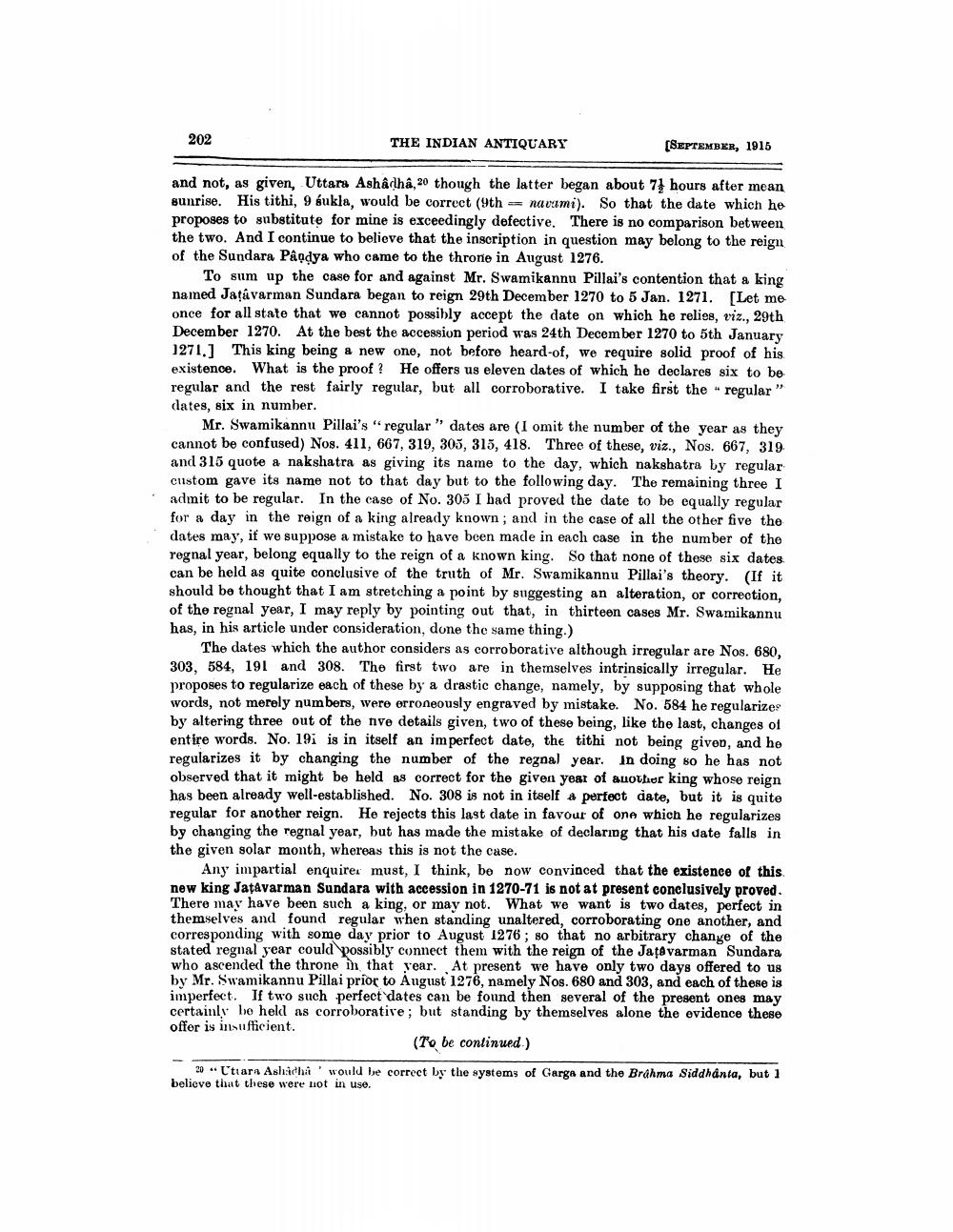________________
202
THE INDIAN ANTIQUARY
[SEPTEMBER, 1915
and not, as given, Uttara Ashâdha, 20 though the latter began about 7 hours after mean sunrise. His tithi, 9 bukla, would be correct (9th == navami). So that the date which he proposes to substitute for mine is exceedingly defective. There is no comparison between the two. And I continue to believe that the inscription in question may belong to the reign of the Sundara Pâodya who came to the throne in August 1276.
To sum up the case for and against Mr. Swamikannu Pillai's contention that a king named Jafavarman Sundara began to reign 29th December 1270 to 5 Jan. 1271. (Let me once for all state that we cannot possibly accept the date on which he relies, viz., 29th December 1270. At the best the accession period was 24th December 1270 to 5th January 1271.] This king being a new one, not before heard-of, we require solid proof of his existence. What is the proof? He offers us eleven dates of which he declares six to be regular and the rest fairly regular, but all corroborative. I take first the "regular" dates, six in number.
Mr. Swamikannu Pillai's "regular" dates are (1 omit the number of the year as they cannot be confused) Nos. 411, 667, 319, 305, 315, 418. Three of these, viz., Nos. 667, 319 and 315 quote a nakshatra as giving its name to the day, which nakshatra by regular custom gave its name not to that day but to the following day. The remaining three I admit to be regular. In the case of No. 305 I bad proved the date to be equally regular for a day in the reign of a king already known, and in the case of all the other five the dates may, if we suppose a mistake to have been made in each case in the number of the regnal year, belong equally to the reign of a known king. So that none of these six dates can be held as quite conclusive of the truth of Mr. Swamikannu Pillai's theory. (If it should be thought that I am stretching a point by suggesting an alteration, or correction, of the regnal year, I may reply by pointing out that, in thirteen cases Mr. Swamikannu has, in his article under consideration, done the same thing.)
The dates which the author considers as corroborative although irregular are Nos. 680, 303. 584, 191 and 308. The first two are in themselves intrinsically irregular. He proposes to regularize each of these by a drastic change, namely, by supposing that whole words, not merely numbers, were erroneously engraved by mistake. No. 584 he regularizes by altering three out of the nve details given, two of these being, like the last, changes of entire words. No. 191 is in itself an imperfect date, the tithi not being given, and he regularizes it by changing the number of the regoal year. In doing so he has not observed that it might be held as correct for the given year of another king whose reign has been already well-established. No. 308 is not in itself a perfect date, but it is quite regular for another reign. He rejects this last date in favour of one which he regularizes by changing the regnal year, but has made the mistake of declaring that his date falls in the given solar month, whereas this is not the case.
Any impartial enquirer must, I think, be now convinced that the existence of this new king Jatavarman Sundara with accession in 1270-71 is not at present conclusively proved. There may have been such a king, or may not. What we want is two dates, perfect in themselves and found regular when standing unaltered, corroborating one another, and corresponding with some day prior to August 1276 ; so that no arbitrary change of the stated regnal year could possibly connect them with the reign of the Jatavarman Sundara who ascended the throne in that year. At present we have only two days offered to us by Mr. Swamikannu Pillai prior to August 1276, namely Nos. 680 and 303, and each of these is imperfect. If two such perfect dates can be found then several of the present ones may certainly be held as corroborative; but standing by themselves alone the evidence these offer is insufficient.
(To be continued.)
20 Ctuara Ashachi' would be correct by the systems of Garga and the Brahma Siddhanta, but 1 believe that these were not in use.




